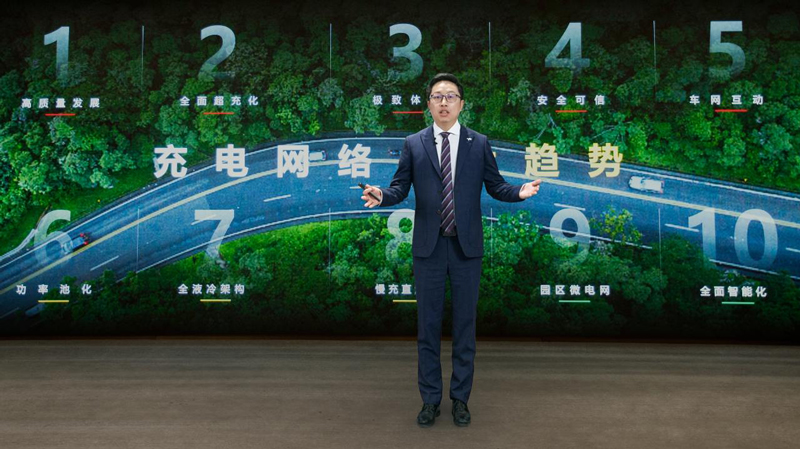[Shenzhen, China, January 30, 2024] Huawei released the Top 10 Trends of Charging Network 2024 on January 30 with the theme of "High-Quality Charging Anywhere." At the release, Wang Zhiwu, President of Huawei Smart Charging Network Domain, comprehensively interpreted the Top 10 Trends of Charging Network 2024 from the perspectives of technology and industry.

Wang Zhiwu stated that in the past three years, electric vehicles (EVs) have grown beyond expectations. In the next decade, there will be at least a 10-fold increase in the number of EVs on the road, and an 8-fold increase in the EV charging demand. As the immature charging network remains the primary pain point of the entire EV industry, building a high-quality charging network will accelerate the new electric vehicle (NEV) penetration and boost the local industry and ecosystem.
As the world is accelerating the pace toward mobility electrification and carbon neutrality, Huawei released the Top 10 Trends of Charging Network 2024 based on in-depth insights and aspirations for high-quality charging anywhere together with partners in the industry.
Trend 1: High-Quality Development
High-quality development of the charging network is a common aspiration across the industry. To this end, there are four major paths: unified planning and design, unified technical standards, unified government supervision, and unified O&M for users.
Trend 2: Comprehensive Ultra-fast Charging
With the maturity of third-generation power semiconductors and high-C-rate traction batteries that use materials such as silicon carbide and gallium nitride, EVs are steering toward the high-voltage ultra-fast charging domain. It is predicted that high-voltage ultra-fast charging vehicle models will account for more than 60% of the total vehicle models in 2028.
Trend 3: Optimal Experience
NEVs are going viral at a fast pace. Passenger vehicle owners replace commercial vehicle owners as the main users, and therefore the mainstream charging preference shifts from low cost to optimal experience.
Trend 4: Security and Trustworthiness
With the continuous penetration of NEVs, the industry is facing an exponential explosion of data volume, posing great challenges in ensuring electrical safety and cybersecurity. A secure and trustworthy charging network features no privacy leakage, no electric shock, no fire accident, and no service breakdown.
Trend 5: Vehicle-Grid Interaction
As the grid is facing greater randomness in power generation and consumption, the charging network will play a vital role in the new power system where renewable energy is the main energy source. Along with the growth path of business models and technologies, the vehicle-grid interaction will go through three key phases: one-way coordination, one-way response, and two-way interaction.
Trend 6: Power Pooling
Traditional integrated chargers do not support power sharing, and therefore cannot solve the issues in case of uncertain MAP, uncertain SOC, uncertain vehicle models, and uncertain idle/busy status during charging. As a result, the grid power utilization for charging is less than 10%. To overcome this pain point, the charging facilities are shifting from the integrated charger architecture to the power pooling architecture to meet the charging power requirements of different vehicle models at different SOC levels. In addition, intelligent scheduling meets the charging requirements of all vehicle models and contributes to improving grid power utilization, reducing site construction costs, and supporting the long-term evolution of vehicles.
Trend 7: Fully Liquid-Cooled Charging
Charging facilities that adopt the mainstream air cooling or semi-liquid cooling modes have a high annual failure rate and short service life, greatly increasing the maintenance costs of site operators. In comparison, charging facilities that completely adopt the liquid cooling mode have a lower annual failure rate of less than 5‰ and a service life of more than 10 years, and can adapt to various environments, slashing O&M costs.
Trend 8: DC Power Normal Charging
In a campus with integrated parking and charging, vehicles can maintain grid-connected for a long period of time, which lays the foundation for vehicle-grid interaction and therefore makes it a core application scenario. However, AC chargers cannot be applied in this scenario due to two major defects. One is no interaction with the grid, which makes chargers impossible to support V2G in the future. The other defect is no vehicle-charger interaction due to a lack of digital tools. The future campuses with integrated parking and charging, the small-power DC charging solution will be more popular and applied on a large scale. Compared with traditional AC chargers, the DC charging solution will achieve optimal charging, higher grid power utilization, and long-term evolution to V2G interaction.
Trend 9: Campus Microgrid
In the future, campuses are likely to integrate PV systems, ESSs, chargers, loads, vehicles, and cloud systems through unified cloud-based management to achieve higher economic benefits from electricity and grid friendliness.
Trend 10: All Intelligence
Isolated management of the networks, stations, devices, and vehicles is caused by the lack of an advanced digital charging network. Such a situation will be changed in the future. These isolated parties will be integrated into an intelligent charging network to facilitate vehicle-charger collaboration, vehicle-grid interaction, and digital O&M.
We are at the forefront of a promising industry and ready to embrace a future with great opportunities. Huawei will continuously increase R&D and technical investments, and build charging network solutions favored by vehicle owners, trusted by operators, and friendly to the grid. Huawei will also work with partners such as automakers and operators to build an ecosystem, and provide high-quality charging anywhere for vehicle owners to travel at will.

 Search
Search




 Search
Search


